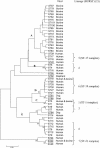Hyperinvasive neonatal group B streptococcus has arisen from a bovine ancestor
- PMID: 15131184
- PMCID: PMC404684
- DOI: 10.1128/JCM.42.5.2161-2167.2004
Hyperinvasive neonatal group B streptococcus has arisen from a bovine ancestor
Abstract
The genetic relatedness and evolutionary relationships between group B streptococcus (GBS) isolates from humans and those from bovines were investigated by phylogenetic analysis of multilocus sequence typing data. The collection of isolates consisted of 111 GBS isolates from cows with mastitis and a diverse global collection of GBS isolates from patients with invasive disease (n = 83) and carriers (n = 69). Cluster analysis showed that the majority of the bovine isolates (93%) grouped into one phylogenetic cluster. The human isolates showed greater diversity and clustered separately from the bovine population. However, the homogeneous human sequence type 17 (ST-17) complex, known to be significantly associated with invasive neonatal disease, was the only human lineage found to be clustered within the bovine population and was distinct from all the other human lineages. Split decomposition analysis revealed that the human isolate ST-17 complex, the major hyperinvasive neonatal clone, has recently arisen from a bovine lineage.
Figures



References
-
- American Academy of Pediatrics Committee on Infectious Diseases and Committee on Fetus and Newborn. 1997. Revised guidelines for prevention of early-onset group B streptococcal (GBS) infection. Pediatrics 99:489-497. - PubMed
-
- American College of Obstetricians and Gynecologists Committee on Obstetric Practice. 1996. Prevention of early-onset group B streptococcal disease in newborns. ACOG committee opinion. American College of Obstetricians and Gynecologists, Washington, D.C. - PubMed
-
- Baker, C. J., and M. S. Edwards. 1995. Group B streptococcal infections, p. 980-1054. In J. Remington and J. O. Klein (ed.), Infectious diseases of the fetus and newborn infant. The W. B. Saunders Co., Philadelphia, Pa.
-
- Baseggio, N., P. D. Mansell, J. W. Browning, and G. F. Browning. 1997. Strain differentiation of isolates of streptococci from bovine mastitis by pulsed-field gel electrophoresis. Mol. Cell. Probes 11:349-354. - PubMed
-
- Breed, R. S. (ed.). 1957. Bergey's manual of determinative bacteriology, 7th ed., p. 517-518. The Williams & Wilkins Co., Baltimore, Md.
Publication types
MeSH terms
Substances
Grants and funding
LinkOut - more resources
Full Text Sources
Other Literature Sources

